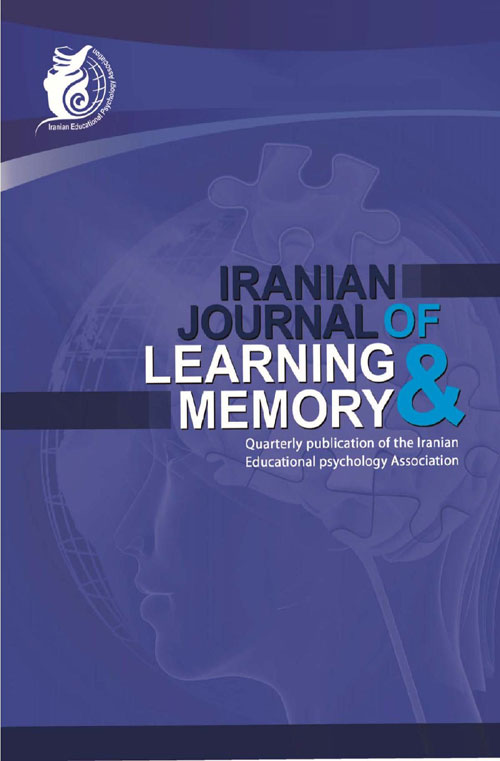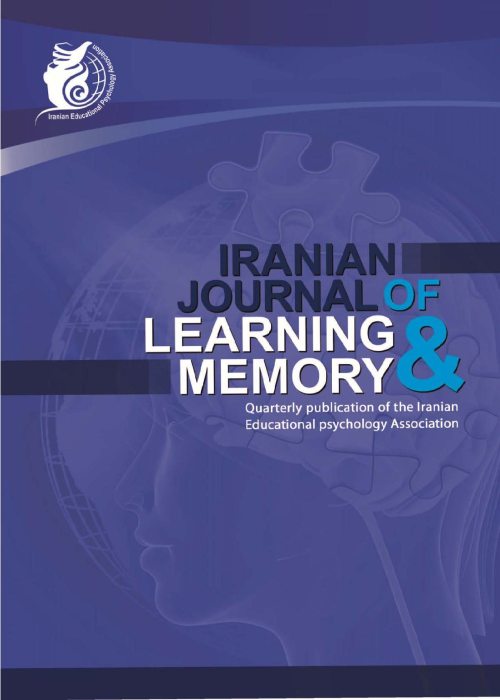فهرست مطالب

Iranian Journal of Learning and Memory
Volume:4 Issue: 16, Winter 2022
- تاریخ انتشار: 1401/05/31
- تعداد عناوین: 7
-
-
Pages 7-18The current study aimed to propose a model for academic emotions based on the quality of parent-child relationships by the mediation of the psychological capital. It was conducted as a descriptive-correlation study and the data were analyzed using the structural equation modeling. The statistical population consisted of all the 10th-grade female students in the 5th district of Tehran during 2016-17 with a population of about 4,000 students, of which Four hundred of them were randomly selected using multi-stage cluster sampling. Fine, J. Morland and Schubel Parent-Child Relationship Scale (PCRS) (1983), Lutans and Avilo Psychological Capital Questionnaire (PCQ) (2007), and Pekrun, Goetz, and Frenzel Academic Emotion Questionnaire (AEQ) (2005) were used to collect data. The data were analyzed using SPSS and LISREL (p<0.05). The results showed that academic emotions were directly affected by the quality of father-child and mother-child relationships and the psychological capital. Moreover, the quality of parent-child relationships indirectly affected academic emotions by the mediation of the psychological capital. The findings of this study can be applied to increase students' positive emotions and decrease their negative emotions by improving the quality of parent-child relationships and the psychological capital variables (i.e., self-efficacy, hope, resilience, and optimism).Keywords: Academic Emotions, parent-child relationship quality, Father-child relationship quality, Mother-child relationship quality, psychological capital
-
Pages 19-28The present study aimed to explore the effectiveness of group counseling of mindfulness-based cognitive therapy on internet addiction and cognitive emotion regulation in high school students. The research design was quasi-experimental and pretest-posttest type and a two-month follow-up with a control group. The population consisted of all male high school students in Takestan city in the academic year 2020-2021. The sample comprised 30 high school male students selected through convenience sampling method and randomly assigned to experimental (n = 15) and control (n = 15) groups. The experimental group then received 10 sessions of 90-minute group counseling of mindfulness-based cognitive therapy, and the control group did not receive any intervention. Data were gathered by Young’s Internet Addiction Questionnaire (IAQ) and the Cognitive Emotion Regulation Questionnaire (CERQ). The researcher also used multivariate analysis of covariance, repeated measures, LSD post hoc test and SPSS-26 software for data analysis. The results of comparing the experimental and control groups indicated that group counseling of mindfulness-based cognitive therapy had a significant effect on Internet addiction in high school students (P < 0.01). Furthermore, the results showed that Group counseling of mindfulness-based cognitive therapy had a significant effect on cognitive emotion regulation (P < 0.01). The findings indicated that group counseling of mindfulness-based cognitive therapy is an effective intervention in reducing Internet addiction and cognitive emotion regulation of secondary high school students.Keywords: Mindfulness-based cognitive therapy, Internet addiction, Cognitive emotion regulation
-
Pages 29-41Many scholars have long contributed to making the instruction of oral production more effectively. This study compared three task types (information-gap, reasoning-gap, and opinion-gap tasks) and two cognitive styles (field-independence and field-dependence) regarding their effects on English as a foreign language (EFL( learners’ oral production linguistic complexity. The current study was quantitative in research methodology and followed the comparison group design. Initially, 230 Iranian learners were selected using convenience sampling. After the participants sat the proficiency test, the number of participants was reduced to 180 BA students at the university of Mohaghegh Ardabili and Islamic Azad University, Ardabil Branch. They were randomly divided into six experimental groups. Two groups were randomly assigned to field-independent (FI) and field-dependent (FD) information-gap tasks, the next two groups to FI and FD reasoning-gap tasks, and the other two groups to FI and FD opinion-gap task types. Each group consisted of 30 advanced EFL learners and was taught oral production using one of the above-mentioned task types. Michigan test of English Language Proficiency test (Phakiti, 2003) and group embedded figures test (Witkin et al., 1971) were used to determine proficiency level and measure cognitive styles. A two-way ANCOVA (analysis of covariance) procedure was run to examine the data. The results revealed significant differences among task types and cognitive styles, with FD learners and opinion-gap task being the most effective on EFL Learners' oral production linguistic complexity. The interaction between cognitive styles and task types is more likely to account for language learners’ oral performance.Keywords: Cognitive styles, Linguistic complexity, Metadiscourse, Oral Performance, task types
-
Pages 43-54This study aimed to evaluate the effect of web-based games on facilitating and enhancing reading and writing skills in learning English vocabulary. The research employed a pre-test and post-test experimental design with a control and an experiential group. Thirty-six elementary students at fourth, fifth, and sixth grades from the west of Tehran were selected as the participants who were randomly assigned to research groups. The experimental group used web-based games. Then, a checklist developed by the researchers was used to assess learning and facilitation in the two groups. Having examined the differences between the experimental group and control group by removing the pretest factor and by controlling the effect of the pretest, the study showed a significant difference in posttest (P <0.05 and F = 32.79) between the two groups. As a result, the hypothesis that educational intervention (web-based games) had a significant effect on reading and writing scores was confirmed with 95% confidence. The following results were obtained from statistical analyses: (a) Web-based learning has a significant effect on facilitating the learning of English vocabulary; and (b) Web-based learning has a significant effect on improving reading and writing skills. Therefore, the findings of this study show that using web-based games can be effective in facilitating and increasing reading and writing skills in learning English vocabulary.Keywords: facilitation, reading, writing skills, vocabulary learning, web-based games
-
Pages 55-62In the present study, the effect of visual and auditory accuracy training strategies on improving reading performance in second-grade dyslexic students was investigated. The statistical population of this study was estimated to be 900 second grade elementary school students with dyslexia in Sabzevar in 2017. According to the study population, a sample of 30 dyslexic children referred to the Learning Disorders Center was selected by multistage cluster random sampling and randomly divided into three groups of ten (two experimental and one Control group) The research method was quasi-experimental with a pretest-posttest design. The instruments used in the study were the Wechsler Intelligence Scale for children (WISC-R), the reading performance test, and the teacher checklist. The experimental group participated in 12 sessions of audio-visual accuracy training while the control group received their instruction by the conventional teaching method during the same period. The duration of each session was 45 minutes. The obtained data were analyzed by covariance analysis method, and the results indicated that there is a significant difference between the adjusted mean of participants' reading error scores in the visual acuity group and the control group (p <0.0001). It was also found that visual and auditory accuracy training is practical in the reading progression of dyslexic students. Reinforcement of Visual and Auditory Accuracy Training Strategies as a prerequisite for neuropsychological neuropathy leads to improved reading performance in students with learning disabilities.Keywords: audio, visual accuracy, training Strategies, dyslexia, Reading Progress
-
Pages 63-70In early 2020, the coronavirus outbreak compelled higher education institutions worldwide to cancel campus-based teaching and conduct a variety of electronic learning which led to assessment of the quality of e-learning and its results, such as learning and self-efficacy. Thus, this study aimed to determine the effect of problem-based e-learning (PBe-L) on the learning and academic efficacy of students during the COVID-19 pandemic in ‘An Introduction of Educational Technology Course’. The research method was quasi-experimental with pre-test/ post-test design with experimental and control groups. The statistical population of this study consisted of undergraduate students in the field of educational sciences studying in the University of Tehran. 38 students were selected as the research sample using the available sampling method and were randomly divided into experimental and control groups. PBe-L was conducted for the experimental group and the control group experienced the direct learning approach. A researcher-made learning test and Morgan-Jinks Student Efficacy Scale (1999) were used. The results showed that the mean of learning and self-efficacy of the experimental group increased from 7.92 and 57.00 in the pre-test to 18.51 and 76.57 in the post-test respectively. The results of covariance showed that the mean scores of the post-test of the two groups were statistically significant (p≥0.005). The results of this study showed that the use of PBe-L during the COVID-19 pandemic can be effective in increasing the students’ learning and academic efficacy.Keywords: Academic Efficacy, COVID-19, E-learning, Problem based learning, Learning
-
Pages 71-83Promotional gift is one of the tools to promote non-monetary sales that has various dimensions and these dimensions can affect the attitude of customers and ultimately their intention to buy. The purpose of this study is to investigate the effect of promotional gifts on customer attitude and observational learning. The statistical population of the study is all customers of Ofogh Kourosh store branches in Birjand. The size of the community in this study is unlimited. The number of samples using Morgan table is 384 people that questionnaire was distributed among the sample by available sampling method. This research is a descriptive, descriptive-causal research in terms of nature and method and an applied research in terms of purpose. To collect the data, standard questionnaires of promotional gifts of Zhu et al. (2015), observational learning of Khawaja (2013), and customer attitude of Stafford (1996) were used. The reliability of the questionnaires in this study is 0.885, 0.894 and 0.743, respectively. Descriptive indicators and structural equation modeling were used to analyze the data with the help of SPSS and PLS software. The results of data analysis showed that promotional gifts have a significant effect on customer attitude (with a path coefficient of 0.694) and on observational learning (with a path coefficient of 0.790).Keywords: promotional gifts, customer attitude, Observational learning


